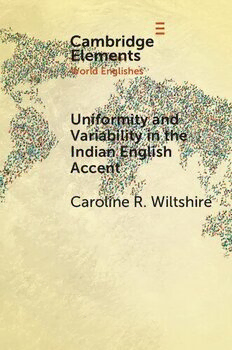
Uniformity and Variability in the Indian English Accent PDF
Preview Uniformity and Variability in the Indian English Accent
World Englishes Uniformity and Variability in the Indian English Accent Caroline R. Wiltshire ElementsinWorldEnglishes editedby EdgarW.Schneider UniversityofRegensburg UNIFORMITY AND VARIABILITY IN THE INDIAN ENGLISH ACCENT Caroline R. Wiltshire University of Florida UniversityPrintingHouse,CambridgeCB28BS,UnitedKingdom OneLibertyPlaza,20thFloor,NewYork,NY10006,USA 477WilliamstownRoad,PortMelbourne,VIC3207,Australia 314–321,3rdFloor,Plot3,SplendorForum,JasolaDistrictCentre, NewDelhi–110025,India 79AnsonRoad,#06–04/06,Singapore079906 CambridgeUniversityPressispartoftheUniversityofCambridge. ItfurtherstheUniversity’smissionbydisseminatingknowledgeinthepursuitof education,learning,andresearchatthehighestinternationallevelsofexcellence. www.cambridge.org Informationonthistitle:www.cambridge.org/9781108823272 DOI:10.1017/9781108913768 ©CarolineR.Wiltshire2020 Thispublicationisincopyright.Subjecttostatutoryexception andtotheprovisionsofrelevantcollectivelicensingagreements, noreproductionofanypartmaytakeplacewithoutthewritten permissionofCambridgeUniversityPress. Firstpublished2020 AcataloguerecordforthispublicationisavailablefromtheBritishLibrary. ISBN978-1-108-82327-2Paperback ISSN2633-3309(online) ISSN2633-3295(print) Additionalresourcesforthispublicationatwww.cambridge.org/wiltshire CambridgeUniversityPresshasnoresponsibilityforthepersistenceoraccuracyof URLsforexternalorthird-partyinternetwebsitesreferredtointhispublication anddoesnotguaranteethatanycontentonsuchwebsitesis,orwillremain, accurateorappropriate. Uniformity and Variability in the Indian English Accent ElementsinWorldEnglishes DOI:10.1017/9781108913768 Firstpublishedonline:November2020 CarolineR.Wiltshire UniversityofFlorida Authorforcorrespondence:CarolineR.Wiltshire,wiltshir@ufl.edu Abstract:ThesoundsofIndianEnglisharedistinctandrecognizableto outsiders,whileinsidersperceivevariationsinhowEnglishhas developedinthislargediversepopulation.Whatcharacteristicsmark theunity?Whicharecluestoaspeaker’soriginsoridentity?This Elementsynthesizesresearchoverthepastfiftyyearsandaddstoit, focusingonselectedfeaturesofconsonants,vowels,and suprasegmentals(stress,intonation,rhythm)tounderstandthe characteristicsofIndianEnglishaccentsandsourcesofitsuniformity andvariability.Theseaccentfeatures,perceptiblebyhumansand discoverablebycomputationalapproaches,maybeusedinexpressing identity,bothlocalandpan-Indian. Keywords:IndianEnglish,dialectvariation,accents,secondlanguage acquisition,languagecontact ©CarolineR.Wiltshire2020 ISBNs:9781108823272(PB),9781108913768(OC) ISSNs:2633-3309(online),2633-3295(print) Contents 1 Introduction 1 2 LinguisticSituationinIndia 2 3 Consonants 17 4 Vowels 36 5 Suprasegmentals 51 6 Variation:Perception(s)andAttitudes 63 7 Conclusions 70 Appendix 75 References 77 UniformityandVariabilityintheIndianEnglishAccent 1 1Introduction India may have the second largest population of English speakers in the world, with over 122 million citizens of India describing themselves as speakersofEnglishinthe2011Census.Thecodificationofthesoundsystem of“IndianEnglish”asadistinctvarietybeganapproximatelyfiftyyearsago (CIEFL1972,Kachru1983,Bansal&Harrison2013[1972]),andcontinues to this day (Sailaja 2009, Pandey 2015). However, descriptions of the phoneticsandphonologyofIndianEnglish(IndE)revealatensionbetween perhapsaspirationalportrayalsofIndEasaunifiedaccentwithasinglesetof normsvs.detaileddescriptionsofvarietiesofEnglishinIndiabasedprimar- ily on the first languages (L1s) of the speakers (e.g., Nagarajan 1985, Jose 1992, Wiltshire & Harnsberger 2006). There are also occasional claims of regional variations (Gargesh 2004) and commonalities (Wiltshire 2005, Wiltshire2015). StudiesonvariationwithinIndEhavedocumenteddifferencesintermsof consonant and vowel inventories, allophonics, phonotactics, and supraseg- mentals like stress, intonation, and rhythm. On the other hand, recent researchsuggeststhatIndE,especiallythatofeducatedurbanspeakers,has been converging toward a more homogeneous standard. Maxwell and Fletcher (2009: 66) claim that “that there are a range of shared vowel categories across speakers of IndE of different L1 backgrounds,” based on comparing results from Hindi and Punjabi L1 speakers with those from speakersofotherL1backgrounds,suchasTamilandGujarati(Wiltshire& Harnsberger 2006). Sirsa and Redford (2013) found both segmental and prosodic similarities among speakers of two different L1s, Hindi and Telugu,summarizingtheirresultsaslargelyconsistentwiththeirhypothesis thatIndEhasphonologicaltargetsdistinctfromthoseofIndianlanguages. This Element explores questions of what unites IndE accents across the nation, what distinguishes subvarieties, and, to the extent possible, what are thesourcesoftheseaccentfeatures.AsEnglishinIndia,likeEnglishevery- where, has developed through contact and over time, theories of language development (e.g., Mufwene 2001, Schneider 2003, 2007, Trudgill 2004) suggest sources of both uniformity and variability may be found through an examinationoffoundervarieties,substrates,linguisticmarkedness,andpro- cesses such as dialect leveling, koineization, and focusing. I begin with an overalldescriptionofthelinguisticsituationinIndiaandEnglish’splaceinit, along with discussions of the object of study (“IndE accent”) and potential factorsinvolvedinitsdevelopment(Section2).Ithencombinethefindingsof acoustic studies, including my own, on IndE sounds, from consonants and 2 WorldEnglishes vowelsthroughsuprasegmentals(Sections3–5),evaluatingpossibleunifying anddistinguishingcharacteristicsandtheirsources.InSection6,Ireporton theabilityofIndEspeakersandcomputationalanalysestoperceivevariation within IndE, and speakers’ attitudes toward variation and identity, before discussingtheoverallfindingsandareasforfutureresearchinSection7. 2LinguisticSituationinIndia IfirstprovidebriefdescriptionsoftherangeoflanguagesusedinIndia(Section 2.1),thecurrentstatusofEnglish(Section2.2),themeaningsoftheterm“Indian English” and its use in this Element (Section 2.3), and potential sources of uniformityandvariabilityinthedevelopmentofEnglishinIndia(Section2.4). 2.1LanguagesinIndia Indiaishometoalargenumberoflanguages(Figure1);the2011Censuslisted 121 languages with over 10,000 native speakers each (Government of India 2011),whileEthnologue1listsatotalof447livinglanguages. Thevastmajorityoflanguagesfallintofourdistinctlanguagefamilies:Indo- Aryan(originallyfromtheWest),Dravidian(alwaysinIndia),Tibeto-Burman, and Austroasiatic (both from the East). Most of India’s population speaks an Indo-Aryan or Dravidian language as their L1 (see Table 1 for examples). Although historically unrelated to each other, languages from the Indo-Aryan andDravidianfamilieshavebeenincontactformillennia;manyhavecometo sharelinguisticfeatures,leadingtodescriptionsofIndiaasa“LinguisticArea” (Emeneau 1956, Masica 1976). However, the Tibeto-Burman languages, spoken in the northeast of the country and relatively isolated from the rest of India, are phonologically and phonetically quite distinct. For example, most Tibeto-Burman languages lack retroflex consonants but have phonemic tone, whileIndo-AryanandDravidianlanguagesgenerallyhaveretroflexconsonants and lack tone. Assamese, genetically an Indo-Aryan language, is in close proximity with Tibeto-Burman languages and shares some characteristics withitsneighbors,includingalackofretroflexion. Table1providesbackgroundaboutthedistributionofeighteenlanguagesin India, with the number of speakers reporting each as a “mother tongue” (L1) fromthe2011census(GovernmentofIndia2011);thesespecificlanguagesare chosen because they are referred to in the research below. This census also asked speakers to report any second or third languages, and for the L1s here IhaveincludedthenumberwhoreportedEnglishasanL2/L3. 1 www.ethonologue.com/country/IN.Accessed2020/1/16. UniformityandVariabilityintheIndianEnglishAccent 3 Figure1StatesandunionterritoriesofIndiabythemostcommonlyspokenL12 All numbers are self-reports and may be problematic in a variety of ways (Kohli2017providesagoodcritique).Forexample,itisunclearwhatspeakers mean when describing a language as their “mother tongue”; it may be the languageoftheirmother,whetherornottherespondentspeaksitbestorfirst. Thereisnoprovisionforindicatinglevelofcompetenceoramountofusefor anyofthelanguageslisted.ThoselistingEnglishasL2/L3mayrangewidelyin both:atoneextreme,peoplewhoattendedEnglish-mediumschoolsfrompre- kindergartenandcurrentlyuseEnglishdailywithfriendsandwork-colleagues, and at the other, people who grew up with a different language and first encountered English as a school subject at age twelve or later, with little use foritafterleavingschool. The census calculated overall rates of bilingualism (26 per cent) and trilingualism (7.1 per cent) of the population (Government of India 2011), both of which are surely too low. Sridhar (1989) suggests reasons for the 2 https://commons.wikimedia.org/w/index.php?curid=51479325 Table1NumberofspeakersofL1sandthoseknowingEnglish(GovernmentofIndia2011). Primarily NumberofL1 Numberof Numberof Family Language spokenin speakers EnglishL2 EnglishL3 Indo-European English Throughout 259,578 76,578,017 45,554,093 Dravidian Kannada Karnataka 43,706,512 3,450,332 962,147 Malayalam Kerala 34,838,819 6,728,063 890,036 Tamil TamilNadu 69,026,881 12,325,941 783,805 Telugu AndhraPradesh 81,127,740 8,074,805 2,900,566 Indo-Aryan Assamese Assam 15,311,351 984,983 748,554 Bangla WestBengal 97,237,669 4,710,845 1,812,485 Gujarati Gujarat 55,492,554 937,868 6,752,677 Hindi UP,MP 528,347,193 32,018,890 3,238,254 Marathi Maharashtra 83,026,680 1,395,659 10,220,047 Oriya/Odia Odisha 37,521,324 4,879,878 2,045,591 Punjabi Punjab 33,124,726 2,036,498 7,828,657 Tibeto-Burman Angami/Tenyidie Nagaland 152,796 62,322 11,833 Ao Nagaland 260,008 71,657 21,604 Meitei/Manipuri Manipur 1,761,079 480,817 108,473 Mizo/Lushai Mizoram 830,846 149,076 7,247 Bodo(Boro) Assam 1,482,929 31,991 38,584 Austroasiatic Khasi Meghalaya 1,431,344 237,173 16,944
